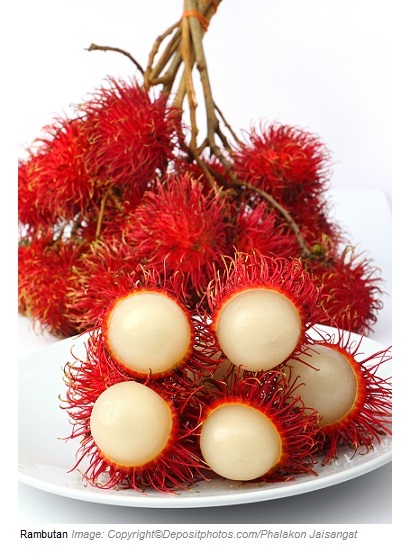Rambutan is a fruit native to Malaysia and Indonesia, but it is also cultivated in the tropical countries of Southeast Asia such as the Philippines, Vietnam and Thailand. The Rambutan fruit is round to ovoid in shape and 4-7 cm in size. It has a red, orange or yellow peel covered with hairy protuberances. Rambutan is closely related to the fruit Lychee. Approximately 82% of the fruit is water.
Average calories: 84 per 100 grams of fruit.
the tropical countries of Southeast Asia such as the Philippines, Vietnam and Thailand. The Rambutan fruit is round to ovoid in shape and 4-7 cm in size. It has a red, orange or yellow peel covered with hairy protuberances. Rambutan is closely related to the fruit Lychee. Approximately 82% of the fruit is water.
Average calories: 84 per 100 grams of fruit.
Vitamins found in higher amounts: vitamins C, B1, B2, B3, B6, and B9.
Minerals found in higher amounts: manganese, iron and calcium.
Phytonutrients found in higher amounts and their health benefits: the phytochemicals in rambutan are saponins, phenolic compounds and volatile organic compounds. Rambutan is rich in saponins. They are naturally occurring glycosides with antioxidant and anti-cancer activities.
Phenolic compounds demonstrate anti-cancer and anti-inflammatory activities. They also can boost the immune system.
The pleasant aroma of rambutan fruit originates from the volatile organic compounds (VOCs) such as beta-damascenone, vanillin, phenylacetic acid, limonene and cinnamic acid. Beta-damascenone is the major contributor to the aroma of rambutan fruit and the flower roses.
The seeds of rambutan have a bitter taste and contain saturated and unsaturated fats with oleic acid 45%, arachidic acid 34%, stearic acid 14%, ericosenoic acid 4%, palmitic acid 2% and saturate fat 1%.
 the tropical countries of Southeast Asia such as the Philippines, Vietnam and Thailand. The Rambutan fruit is round to ovoid in shape and 4-7 cm in size. It has a red, orange or yellow peel covered with hairy protuberances. Rambutan is closely related to the fruit Lychee. Approximately 82% of the fruit is water.
Average calories: 84 per 100 grams of fruit.
the tropical countries of Southeast Asia such as the Philippines, Vietnam and Thailand. The Rambutan fruit is round to ovoid in shape and 4-7 cm in size. It has a red, orange or yellow peel covered with hairy protuberances. Rambutan is closely related to the fruit Lychee. Approximately 82% of the fruit is water.
Average calories: 84 per 100 grams of fruit.
|
Rambutan: 100 grams |
|
|
Carbohydrate |
21 |
|
Fiber |
2 |
|
Protein |
0 |
|
Fat |
0 |
|
Calories |
84 |

